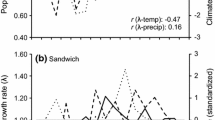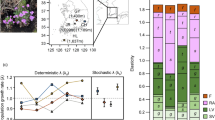Abstract
The central-marginal model assumes unfavourable and more variable environmental conditions at the periphery of a species’ distribution range to negatively affect demographic transition rates, finally resulting in reduced population sizes and densities. Previous studies on density-dependence as a crucial factor regulating plant population growth have mainly focussed on fecundity and survival. Our objective is to analyse density-dependence in combination with the effect of inter-annual variation and range position on all life stages of an annual plant species, Hornungia petraea, including germination and seed incorporation into the seed bank. As previous studies on H. petraea had revealed a pattern opposite to existing theory with lower population densities at the distribution centre in Italy than at the periphery in Germany, we hypothesised that (1) demographic transition rates are lower, (2) the inter-annual variation in demographic transition rates is higher and (3) the intensity of density-dependence is weaker in Italy than in Germany. To analyse demographic transition rates, we used an autoregressive covariance strategy for repeated measures including density and inter-annual variation. All the three hypotheses were confirmed, but the impact of range position, density-dependence and inter-annual variation differed among the transition steps. All transition rates except fecundity were higher in the German populations than in the Italian populations. Germination rate and incorporation rate into the seed bank were strongly density-dependent. Central populations showed a larger inter-annual variation in fecundity and winter survival rate. Winter survival rate was the only transition step with a stronger density-dependence in peripheral populations. In most cases, these differences between distribution centre and periphery would not have emerged without taking density-dependence and inter-annual variation into account. We conclude that including range position, inter-annual variation and density-dependence in one single statistical model is an important tool for the interpretation of demographic patterns regarding the central-marginal model.







Similar content being viewed by others
References
Antonovics J, Levin DA (1980) The ecological and genetic consequences of density-dependent regulation in plants. Annu Rev Ecol Syst 11:411–452
Ballard L (1958) Studies of dormancy in seeds or subterranean clover (Trifolium subterraneum L.). 1. Breaking of dormancy by CO2 and by activated carbon. Aust J Biol Sci 11:246–274
Begon M, Mortimer M, Thompson DJ (1996) Population ecology. Blackwell, Oxford
Brown JH (1984) On the relationship between abundance and distribution of species. Am Nat 124:255–279
Brown JH, Mehlman DW, Stevens GC (1995) Spatial variation in abundance. Ecology 76:2028–2043
Brussard PF (1984) Geographic patterns and environmental gradients: the central-marginal model in Drosophila revisited. Annu Rev Ecol Syst 15:25–64
Cabin RJ, Marshall DL, Mitchell RJ (2000) The demographic role of soil seed banks. 2. Investigations of the fate of experimental seeds of the desert mustard Lesquerella fendleri. J Ecol 88:293–302
Carey PD, Watkinson AR, Gerard FFO (1995) The determinants of the distribution and abundance of the winter annual grass Vulpia ciliata ssp. ambigua. J Ecol 83:177–187
Clay K, Shaw R (1981) An experimental demonstration of density-dependent reproduction in a natural-population of Diamorpha smallii, a rare annual. Oecologia 51:1–6
Crawley MJ (1992) Seed predators and population dynamics. In: Fenner M (ed) Seeds: the ecology of regeneration in plant communities. CAB International, Walingford, pp 157–191
Dorken ME, Eckert CG (2001) Severely reduced sexual reproduction in northern populations of a clonal plant, Decodon verticillatus (Lythraceae). J Ecol 89:339–350
García D, Zamora R, Gómez JM, Jordano P, Hódar JA (2000) Geographical variation in seed production, predation and abortion in Juniperus communis throughout its range in Europe. J Ecol 88:436–446
Gaston KJ (1990) Patterns in the geographical ranges of species. Biol Rev Camb Philos Soc 65:105–129
Harper JL (1977) Population biology of plants. Academic, London
Hengeveld R, Haeck J (1982) The distribution of abundance. 1. Measurements. J Biogeogr 9:303–316
Holt RD (2003) On the evolutionary ecology of species’ ranges. Evol Ecol Res 5:159–178
Jalas J, Suominen J (1996) Atlas Florae Europaeae, vol 11: Cruciferae (Ricotia to Raphanus). Societas Biologica Fennica Vanamo, Helsinki
Jefferies RL, Davy AJ, Rudmik T (1981) Population biology of the salt marsh annual Salicornia europaea agg. J Ecol 69:17–31
Jump AS, Woodward FI (2003) Seed production and population density decline approaching the range-edge of Cirsium species. New Phytol 160:349–358
Kelly D (1989) Demography of short-lived plants in chalk grassland. 1. Life cycle variation in annuals and strict biennials. J Ecol 77:747–769
Kenward MG, Roger JH (1997) Small sample inference for fixed effects from restricted maximum likelihood. Biometrics 53:983–997
Kira T, Ogawa H, Sinozaki K (1953) Intraspecific competition among higher plants. 1. Competition-density-yield interrelationships in regularly dispersed populations. J Inst Polytech Osaka City Univ D 4:1–16
Kluth C, Bruelheide H (2005) Central and peripheral Hornungia petraea populations: patterns and dynamics. J Ecol. 93:584–595
Kluth C, Bruelheide H (2004) Using standardised sampling designs from population ecology to assess biodiversity patterns of therophyte vegetation across scales. J Biogeogr 31:363–377
Knight TM (2003) Floral density, pollen limitation, and reproductive success in Trillium grandiflorum. Oecologia 137:557–563
Koenig WD, Knops JMH, Carmen WJ, Stanback MT (1999) Spatial dynamics in the absence of dispersal: acorn production by oaks in central coastal California. Ecography 22:499–506
Littell RC, Milliken GA, Stroup WW, Wolfinger RD (1996) SAS® system for mixed models. SAS Institute Inc., Cary
Lortie CJ, Turkington R (2002) The effect of initial seed density on the structure of a desert annual plant community. J Ecol 90:435–445
Lundberg P, Ranta E, Ripa J, Kaitala V (2000) Population variability in space and time. Trends Ecol Evol 15:460–464
Mack RN, Pyke DA (1983) The demography of Bromus tectorum: variation in time and space. J Ecol 71:69–93
Maurer BA, Taper ML (2002) Connecting geographical distributions with population processes. Ecol Lett 5:223–231
Murray BR (1998) Density-dependent germination and the role of seed leachate. Aust J Ecol 23:411–418
Nantel P, Gagnon D (1999) Variability in the dynamics of northern peripheral versus southern populations of two clonal plant species, Helianthus divaricatus and Rhus aromatica. J Ecol 87:748–760
Orth RJ, Fishman JR, Harwell MC, Marion SR (2003) Seed-density effects on germination and initial seedling establishment in eelgrass Zostera marina in the Chesapeake Bay region. Mar Ecol Prog Ser 250:71–79
Palmblad IG (1968) Competition in experimental populations of weeds with emphasis on regulation of population size. Ecology 49:26–34
Piepho HP, Büchse A, Richter C (2004) A mixed modelling approach for randomized experiments with repeated measures. J Agron Crop Sci 190:230–247
Pigott CD, Huntley JP (1981) Factors controlling the distribution of Tilia cordata at the northern limits of its geographical range. 3. Nature and causes of seed sterility. New Phytol 87:817–839
Rees M, Brown VK (1991) The effect of established plants on recruitment in the annual forb Sinapis arvensis. Oecologia 87:58–62
Reusch TBH (2003) Floral neighbourhoods in the sea: how floral density, opportunity for outcrossing and population fragmentation affect seed set in Zostera marina. J Ecol 91:610–615
Sagarin RD, Gaines SD (2002a) Geographical abundance distributions of coastal invertebrates: using one-dimensional ranges to test biogeographic hypotheses. J Biogeogr 29:985–997
Sagarin RD, Gaines SD (2002b) The ‘abundant centre’ distribution: to what extent is it a biogeographical rule? Ecol Lett 5:137–147
SAS Institute (2000a) SAS procedures guide, version 8. SAS Institute Inc., Cary
SAS Institute (2000b) SAS/STAT user’s guide, version 8. SAS Institute Inc., Cary
Silvertown JW (1982) Introduction to plant population ecology. Longman, London
Silvertown JW, Charlesworth D (2001) Introduction to plant population biology. Blackwell, Oxford
Stokes KE, Bullock JM, Watkinson AR (2004) Population dynamics across a parapatric range boundary: Ulex gallii and Ulex minor. J Ecol 92:142–155
Symonides E (1979) The structure and population dynamics of psammophytes on inland dunes. 3. Populations of compact psammophyte communities. Ekol Pol 27:235–257
Symonides E (1988) Population dynamics of annual plants. In: Davy AJ, Hutchings MJ, Watkinson AR (eds) Plant population ecology: the 28th Sympossium of the British Ecological Society. Blackwell, Oxford, pp 221–248
Thomas LP (1996) Population ecology of a winter annual (Lesquerella filiformis Rollins) in a patchy environment. Nat Area J 16:216–226
Thompson K, Grime JP (1979) Seasonal variation in the seed banks of herbaceous species in ten contrasting habitats. J Ecol 67:893–921
Thompson K, Bakker JP, Bekker RM (1997) The soil seed banks of North West Europe: methodology, density and longevity. Cambridge University Press, Cambridge
Vandermeer JH, Goldberg DE (2003) Population ecology: first principles. Princeton University Press, Princeton
Watkinson AR (1985) On the abundance of plants along an environmental gradient. J Ecol 73:569–578
Watkinson AR (1990) The population dynamics of Vulpia fasciculata: a nine-year study. J Ecol 78:196–209
Watkinson AR (1997) Plant population dynamics. In: Crawley MJ (ed) Plant ecology. Blackwell, Oxford, pp 359–400
Watkinson AR, Harper JL (1978) Demography of a sand dune annual: Vulpia fasciculata. 1. Natural regulation of populations. J Ecol 66:15–33
Watkinson AR, Lonsdale WM, Andrew MH (1989) Modeling the population-dynamics of an annual plant Sorghum intrans in the wet-dry tropics. J Ecol 77:162–181
Watkinson AR, Freckleton RP, Forrester L (2000) Population dynamics of Vulpia ciliata: regional, patch and local dynamics. J Ecol 88:1012–1029
Watkinson AR, Gill J, Freckleton RP (2003) Macroecology and microecology: linking large-scale patterns of abundance to population processes. In: Gaston KJ, Blackburn TM (eds) Perspectives on large scale ecological processes. Blackwell, Oxford
Williams CK, Ives AR, Applegate RD (2003) Population dynamics across geographical ranges: time-series analyses of three small game species. Ecology 84:2654–2667
Yoda K, Kira T, Ogawa H, Hozumi K (1963) Self-thinning in overcrowded pure stands under cultivated and natural conditions. J Biol Osaka City Univ 14:107–129
Acknowledgements
We thank Christoph Fühner, Stephanie Kluth, Holger Lieneweg, Ute Luginbühl and Gustav Schulz for their assistance in the field. We especially thank Leonardo Gubellini and Aldo Brilli-Cattarini from the Centro Ricerche Floristiche Marche for their assistance in locating Italian plots and their logistic help. We are grateful to two anonymous referees for their valuable and constructive critique on the manuscript. We particularly thank Andreas Büchse who improved the statistical approach. Alexandra Erfmeier and Stephanie Kluth contributed useful comments on previous drafts of the manuscript. This work was supported by a grant of the German Research Foundation DFG (BR 1698/2).
Author information
Authors and Affiliations
Corresponding author
Additional information
Communicated by Christian Koerner
Electronic supplementary material
Rights and permissions
About this article
Cite this article
Kluth, C., Bruelheide, H. Effects of range position, inter-annual variation and density on demographic transition rates of Hornungia petraea populations. Oecologia 145, 382–393 (2005). https://doi.org/10.1007/s00442-005-0141-1
Received:
Accepted:
Published:
Issue Date:
DOI: https://doi.org/10.1007/s00442-005-0141-1




